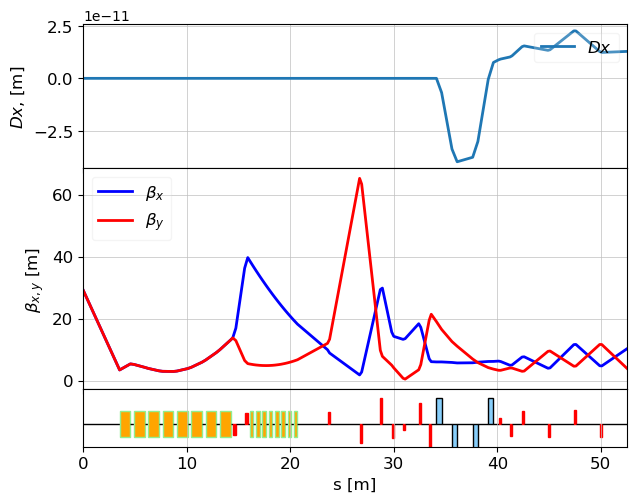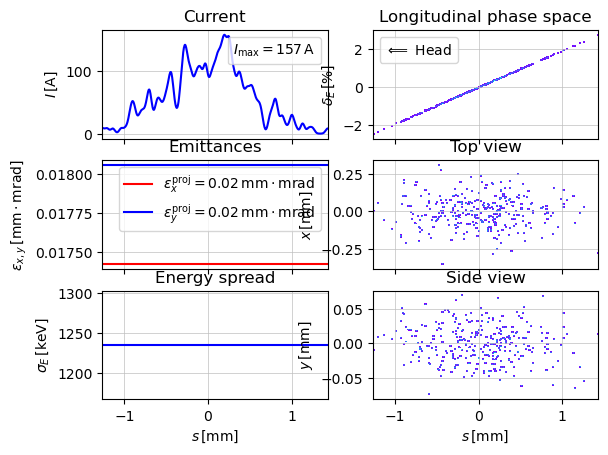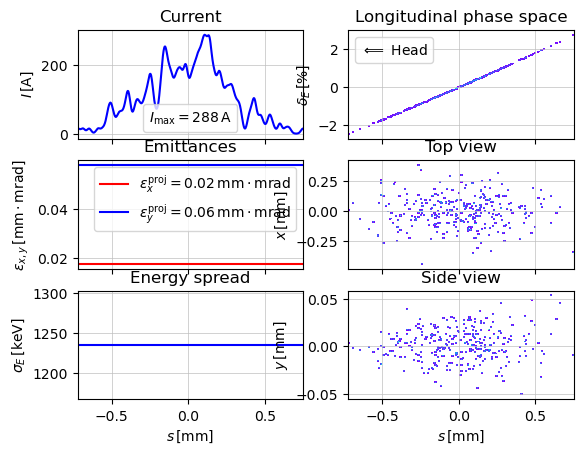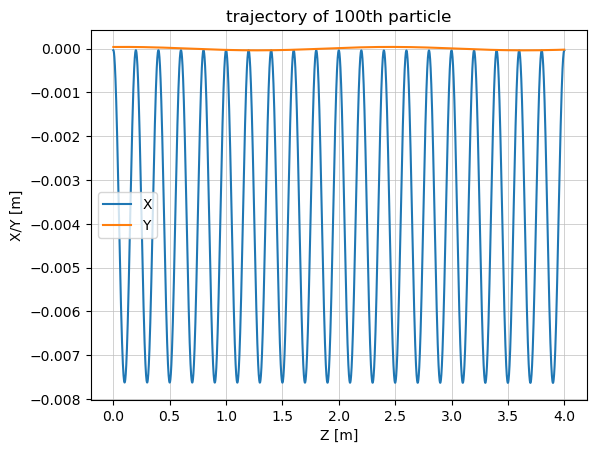*This notebook was created by Sergey Tomin (sergey.tomin@desy.de). July 2019.
9. Accelerator based THz source
In this tutorial we will focus on another feature of the SR module (see PFS tutorial N1. Synchrotron radiation module), namely the calculation of coherent radiation. Details and limitation of the SR module in that mode can be found in G. Geloni, T. Tanikawa and S. Tomin, Dynamical effects on superradiant THz emission from an undulator. J. Synchrotron Rad. (2019). 26, 737-749
As a first step we consider a simple accelerator with the electron beam formation system (bunch compressor). Undulator parameters are chosen to generate radiation in THz range.
Contents
Accelerator
Accelerator includes an accelerator module and linearizer (third harmonic cavity) and a bunch compressor. IN other words we reproduce simplified version of the XFEL injector without the injector dogleg.
Lattice
# To activate interactive matplolib in notebook
# %matplotlib notebook
from ocelot import *
from ocelot.gui import *
import time
initializing ocelot...
#Initial Twiss parameters
tws0 = Twiss()
tws0.beta_x = 29.171
tws0.beta_y = 29.171
tws0.alpha_x = 10.955
tws0.alpha_y = 10.955
tws0.gamma_x = 4.148367385417024
tws0.gamma_y = 4.148367385417024
tws0.E = 0.005
# Drifts
D0 = Drift(l=3.52)
D1 = Drift(l=0.3459)
D2 = Drift(l=0.2043)
D3 = Drift(l=0.85)
D4 = Drift(l=0.202)
D5 = Drift(l=0.262)
D6 = Drift(l=2.9)
D8 = Drift(l=1.8)
D9 = Drift(l=0.9)
D11 = Drift(l=1.31)
D12 = Drift(l=0.81)
D13 = Drift(l=0.50)
D14 = Drift(l=1.0)
D15 = Drift(l=1.5)
D18 = Drift(l=0.97)
D19 = Drift(l=2.3)
D20 = Drift(l=2.45)
# Quadrupoles
q1 = Quadrupole(l=0.3, k1=-1.537886, eid='Q1')
q2 = Quadrupole(l=0.3, k1=1.435078, eid='Q2')
q3 = Quadrupole(l=0.2, k1=1.637, eid='Q3')
q4 = Quadrupole(l=0.2, k1=-2.60970, eid='Q4')
q5 = Quadrupole(l=0.2, k1=3.4320, eid='Q5')
q6 = Quadrupole(l=0.2, k1=-1.9635, eid='Q6')
q7 = Quadrupole(l=0.2, k1=-0.7968, eid='Q7')
q8 = Quadrupole(l=0.2, k1=2.7285, eid='Q8')
q9 = Quadrupole(l=0.2, k1=-3.4773, eid='Q9')
q10 = Quadrupole(l=0.2, k1=0.780, eid='Q10')
q11 = Quadrupole(l=0.2, k1=-1.631, eid='Q11')
q12 = Quadrupole(l=0.2, k1=1.762, eid='Q12')
q13 = Quadrupole(l=0.2, k1=-1.8, eid='Q13')
q14 = Quadrupole(l=0.2, k1=1.8, eid='Q14')
q15 = Quadrupole(l=0.2, k1=-1.8, eid='Q15')
# SBends
b1 = SBend(l=0.501471120927, angle=0.1327297047, e2=0.132729705, tilt=1.570796327, eid='B1')
b2 = SBend(l=0.501471120927, angle=-0.1327297047, e1=-0.132729705, tilt=1.570796327, eid='B2')
b3 = SBend(l=0.501471120927, angle=-0.1327297047, e2=-0.132729705, tilt=1.570796327, eid='B3')
b4 = SBend(l=0.501471120927, angle=0.1327297047, e1=0.132729705, tilt=1.570796327, eid='B4')
# Cavitys
c1 = Cavity(l=1.0377, v=0.01815975, freq=1300000000.0, eid='C1')
c3 = Cavity(l=0.346, v=0.0024999884, phi=180.0, freq=3900000000.0, eid='C3')
und = Undulator(lperiod=0.2, nperiods=20, Kx=30)
start_und = Marker()
end = Marker()
# Lattice
cell = (D0, c1, D1, c1, D1, c1, D1, c1, D1, c1, D1, c1, D1, c1, D1, c1, D2, q1, D3,
q2, D4, c3, D5, c3, D5, c3, D5, c3, D5, c3, D5, c3, D5, c3, D5, c3, D6, q3, D6,
q4, D8, q5, D9, q6, D9, q7, D11, q8, D12, q9, D13, b1, D14, b2, D15, b3, D14, b4, D13,
q10, D9, q11, D18, q12, D19, q13, D19, q14, D19, q15, D20, start_und, und, D14, end)
lat = MagneticLattice(cell, stop=start_und)
tws = twiss(lat, tws0)
plot_opt_func(lat, tws, legend=False, fig_name=100)
plt.show()

Also we can found the main parameters of the chicane with chicane_RTU(yoke_len, dip_dist, r, type)
from ocelot.utils import *
R56, T566, U5666, Sref = chicane_RTU(yoke_len=0.5, dip_dist=D14.l * np.cos(b1.angle), r=b1.l/b1.angle, type="c")
print("bunch compressor R56 = ", R56, " m")
bunch compressor R56 = -0.04751528087514777 m
Simple compression scenario
We consider a simple compression scheme with an accelerator module and third harmonic linearizer and a magnetic chicane. To have full picture of the compression techniques, I would recommend:
- I. Zagorodnov and M. Dohlus, Semianalytical modeling of multistage bunch compression with collective effects
- and M. Dohlus, T. Limberg, and P. Emma, ICFA Beam Dynamics Newsletter 38, 15 (2005)
To compress a bunch longitudinally, the time of flight through some section must be shorter for the tail of the bunch than it is for the head. The usual technique starts out by introducing a correlation between the longitudinal position of the particles in the bunch and their energy using a radio frequency (RF) accelerating system. At the end of a linac which induces an energy chirp , the mapping of longitudinal position and relative energy deviation of an electron is
where is not correlated energy spread along the bunch length.
The transformation of the longitudinal coordinate in compressor BC can be approximated by the expression up to first order:
Taking an ensemble average over all particles in the bunch and by definition , the second moment of the distribution is:
Compression factor is :
Suppose, uncorrelated energy spread is small and we chose and m as we calculated above, in that case the compression factor after the chicane is
The non-linearities of both the accelerating RF fields and the longitudinal dispersion can distort the longitudinal phase space. A higher harmonic RF system can be used to compensate the non-linearities of the fundamental frequency system and the higher order longitudinal dispersion in the magnetic chicanes. To linearize longitudinal phase space, a working point for RF phases and amplitudes must be found for the fundamental frequency and the -th harmonic system (n = 3 for the European XFEL).
The relation between the normalized RF amplitudes
In our case we assume initial beam energy MeV and .
And final energy we chose MeV and with So, our vector on the right side will be
Note: We calculated only for the chicane and did not take into account undulator.
In our case undulator has high K parameter
So, total compression after undulator will be
import scipy.optimize
# M*a = b
k = 2*np.pi/3e8*1.3e9
n = 3
M = np.array([[1, 0, 1, 0],
[0, -k, 0, -(n*k)],
[-k**2, 0, -(n*k)**2, 0],
[0, k**3, 0, (n*k)**3]])
b = np.array([125, -1300, 0, 0])
def F(x):
V1 = x[0]
phi1 = x[1]
V13 = x[2]
phi3 = x[3]
V = np.array([V1*np.cos(phi1*np.pi/180),
V1*np.sin(phi1*np.pi/180),
V13*np.cos(phi3*np.pi/180),
V13*np.sin(phi3*np.pi/180)]).T
return np.dot(M, V) - b
x = scipy.optimize.broyden1(F, [150, 10, 20, 190])
V1, phi1, V13, phi13 = x
print("V1 = ", V1, " MeV")
print("phi1 = ", phi1)
print("V13 = ", V13, " MeV")
print("phi13 = ", phi13)
V1 = 150.53461560292047 MeV
phi1 = 20.905449650430196
V13 = 15.751142632839656 MeV
phi13 = 187.25608275658084
Now we update cavities parameters in the lattice
# type new parameters,
# NOTE in OCELOT cavity voltage in [GeV] so to traslate calculated voltage we need factor 1/1000
# and we have 8 cavities for main RF module and linearizer
c1.v = V1/8/1000
c1.phi = phi1
c3.v = V13/8/1000
c3.phi = phi13
# and update lattice
lat.update_transfer_maps()
<ocelot.cpbd.magnetic_lattice.MagneticLattice at 0x168570ac0>
Generate electron beam
np.random.seed(10)
parray = generate_parray(sigma_x=0.0001, sigma_px=2e-05, sigma_y=None, sigma_py=None,
sigma_tau=0.001, sigma_p=0.0001, chirp=0.0, charge=0.5e-09,
nparticles=300, energy=0.005, tau_trunc=None)
show_e_beam(parray,nparts_in_slice=50,smooth_param=0.1, nbins_x=50, nbins_y=50, nfig=10)
plt.show()

Tracking up to undulator
navi = Navigator(lat)
tws_track, parray = track(lat, parray, navi)
show_e_beam(parray, nfig=201)
plt.show()
z = 52.547084483708005 / 52.54708448370802. Applied:

parray.E
0.13000000268915646
Coherent radiation from the beam
from ocelot.rad import *
lat = MagneticLattice(cell, start=start_und, stop=end)
screen = Screen()
screen.z = 1000.0
screen.size_x = 15
screen.size_y = 15
screen.nx = 1
screen.ny = 1
screen.start_energy = 0.001 # eV
screen.end_energy = 3e-3 # eV
screen.num_energy = 1001
# to estimate radiation properties we need to create beam class
beam = Beam()
beam.E = 0.13
# NOTE: this function just estimate spontanious emmision
print_rad_props(beam, K=und.Kx, lu=und.lperiod, L=und.l, distance=screen.z)
********* ph beam ***********
Ebeam : 0.13 GeV
K : 30
B : 1.6065 T
lambda : 6.96835E-04 m
Eph : 1.77925E-03 eV
1/gamma : 3930.7605 um
sigma_r : 5941.5531 um
sigma_r' : 9332.9698 urad
Sigma_x : 5941.5531 um
Sigma_y : 5941.5531 um
Sigma_x' : 9332.9698 urad
Sigma_y' : 9332.9698 urad
H. spot size : 9332.9717 / 9.333 mm/mrad
V. spot size : 9332.9717 / 9.333 mm/mrad
I : 0.0 A
Nperiods : 20.0
distance : 1000.0 m
flux tot : 0.00E+00 ph/sec/0.1%BW
flux density : 0.00E+00 ph/sec/mrad^2/0.1%BW; 0.00E+00 ph/sec/mm^2/0.1%BW
brilliance : 0.00E+00 ph/sec/mrad^2/mm^2/0.1%BW
start = time.time()
screen_i = coherent_radiation(lat, screen, parray, accuracy=1)
print()
print("time exec: ", time.time() - start, " s")
show_flux(screen_i, unit="mm", title="")
n: 299 / 299
time exec: 100.35891485214233 s

Beam after undulator.
as you can notice, the beam was compressed in the undulator in approximatly in two times as was calculated in the Simple compression scenario
show_e_beam(parray, nfig=203)
plt.show()

Electron trajectories
In some cases, it is worth checking the trajectory of the particle used to calculate the radiation.
For this purpose, a special object BeamTraject is attached to the object screen after radiation calculation:
screen.beam_traj = BeamTraject()
To retrieve trajectory you need to specify number of electron what you are interested, for example:
x = screen.beam_traj.x(n=0)
n = 100
x = screen.beam_traj.x(n)
y = screen.beam_traj.y(n)
z = screen.beam_traj.z(n)
plt.title("trajectory of " + str(n)+"th particle")
plt.plot(z, x, label="X")
plt.plot(z, y, label="Y")
plt.xlabel("Z [m]")
plt.ylabel("X/Y [m]")
plt.legend()
plt.show()
